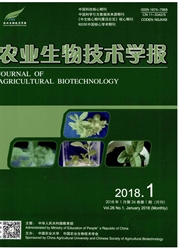

 中文摘要:
中文摘要:
当前铅资源的粗放式开采和使用对环境造成了严重的污染。利用微生物修复铅污染具有费用低、易操作、环境友好等优点,在水体和土壤铅污染治理中具有很好的应用前景。为了了解微生物对铅的吸附特性,本研究从铅锌矿尾矿坝分离到的一株耐铅节杆菌(Arthrobacter sp.)12-1(GenBank登录号:KM362724),并研究其对铅的吸附过程和作用机制。研究耐铅节杆菌12-1在含不同Pb^2+浓度LB培养基中的生长情况表明,其最高可耐受800mg/LPb^2+。在水溶液中,经24h吸附,耐铅节杆菌12-1可将Pb^2+浓度从105mg/L降至2.17mg/L,吸附率为97.93%。显微成像(原子力显微镜,扫描电镜)观察和能谱分析表明,耐铅节杆菌12-1吸附铅后在细胞表面形成含铅的矿物。傅立叶变换红外光谱(FT-IR)分析表明,耐铅节杆菌12-1细胞上的羧基、酰胺和磷酸基团可能参与了铅的吸附和固定过程。以上结果表明,从铅锌矿尾矿坝分离到的耐铅节杆菌12-1对铅具有较好的耐受和吸附能力,显示其在铅污染环境修复中具有潜在的应用前景。本研究为细菌修复铅污染环境的实践提供了理论基础。
 英文摘要:
英文摘要:
The extensive exploitation and usage of lead resources have caused serious environmental pollution problems currently. Bioremediation of Pb2 + contaminated water and soil environments using microbes is regarded as a promising technology due to the advantages of its cost-effective, easy operation and environmental-friendly properties. In order to understand Pb2+ biosorption characterization of microbes, an indigenous lead-resistant bacterium-Arthrobacter sp. 12-1(GenBank No. KM362724) was isolated from lead-zinc mine tailing dam, and the process and mechanism of Pb2+ biosorption by Arthrobacter sp. 12-1 were furtherly investigated in this study. Study on the growth of Arthrobacter sp. 12-1 in LB medium containing different concentration of Pb2+suggested that the highest Pb2+tolerant concentration of Arthrobacter sp. 12-1 was 800 mg/L. In water solution, 105 mg/L of Pb2+could be reduced to 2.17 mg/L by Arthrobacter sp. 12-1 within 24 h with biosorption rate of 97.93%. Microscopic investigation (atomic force microscopy and scanning electronic microscopy) combined with energy dispersive X-ray spectroscopy analysis showed that lead containing mineral was formed on the surface of cell after Pb2+sorption by Arthrobacter sp. 12-1. Further fourier transform infrared (FT- IR) analysis revealed that carboxyl, amide and phosphate groups of Arthrobacter sp. 12-1 might be involved in Pb2 + biosorption process. The results demonstrated that the Arthrobacter sp. 12-1 isolated from lead-zinc mine tailing dam had strong ability of Pb2 + resistance and biosorption, indicating an attractive prospect of practical applications in bioremediation Pb2+ contaminated water and soil environments. The present work provides much fundamental information for help in constructing feasible strategies for Pb2+bioremediation in the environment.
 同期刊论文项目
同期刊论文项目
 同项目期刊论文
同项目期刊论文
 Use of High-Pressure CO2 for Concentrating Cr(VI) from Electroplating Wastewater by Mg-Al Layered Do
Use of High-Pressure CO2 for Concentrating Cr(VI) from Electroplating Wastewater by Mg-Al Layered Do Biomineralization of Pb(II) into Pb-hydroxyapatite induced by Bacillus cereus 12-2 isolated from Lea
Biomineralization of Pb(II) into Pb-hydroxyapatite induced by Bacillus cereus 12-2 isolated from Lea The mechanism of uranium transformation from U(VI) into nano-uramphite by two indigenous Bacillus th
The mechanism of uranium transformation from U(VI) into nano-uramphite by two indigenous Bacillus th EDTA-Induced Self-Assembly of 3D Graphene and Its Superior Adsorption Ability for Paraquat Using a T
EDTA-Induced Self-Assembly of 3D Graphene and Its Superior Adsorption Ability for Paraquat Using a T Adsorption-Induced Crystallization of U-Rich Nanocrystals on Nano-Mg(OH)(2) and the Aqueous Uranyl E
Adsorption-Induced Crystallization of U-Rich Nanocrystals on Nano-Mg(OH)(2) and the Aqueous Uranyl E Cell Rescue by Nanosequestration: Reduced Cytotoxicity of An Environmental Remediation Residue, Mg(O
Cell Rescue by Nanosequestration: Reduced Cytotoxicity of An Environmental Remediation Residue, Mg(O Growth kinetics study revealing the role of the MPA capping ligand on adjusting the growth modes and
Growth kinetics study revealing the role of the MPA capping ligand on adjusting the growth modes and Fabrication of titanium phosphate@graphene oxide nanocomposite and its super performance on Eu3+ rec
Fabrication of titanium phosphate@graphene oxide nanocomposite and its super performance on Eu3+ rec Investigation of Cr(VI) reduction and Cr(III) immobilization mechanism by planktonic cells and biofi
Investigation of Cr(VI) reduction and Cr(III) immobilization mechanism by planktonic cells and biofi The relationship between photoluminescence (PL) decay and crystal growth kinetics in thioglycolic ac
The relationship between photoluminescence (PL) decay and crystal growth kinetics in thioglycolic ac Study of In Situ Formation of Magnesium Hydroxide Whisker via Basic Magnesium Chloride Whisker Regul
Study of In Situ Formation of Magnesium Hydroxide Whisker via Basic Magnesium Chloride Whisker Regul Dynamic Behavior of Interfacial Water on Mg(OH)2 (001) Surface: A Molecular Dynamics Simulation Work
Dynamic Behavior of Interfacial Water on Mg(OH)2 (001) Surface: A Molecular Dynamics Simulation Work Dynamic Behavior of Interfacial Water on Mg(OH)(2) (001) Surface: A Molecular Dynamics Simulation Wo
Dynamic Behavior of Interfacial Water on Mg(OH)(2) (001) Surface: A Molecular Dynamics Simulation Wo Hydrothermal growth of large-size UO2 nanoparticles mediated by biomass and environmental implicatio
Hydrothermal growth of large-size UO2 nanoparticles mediated by biomass and environmental implicatio Mg(OH)(2) Supported Nanoscale Zero Valent Iron Enhancing the Removal of Pb(II) from Aqueous Solution
Mg(OH)(2) Supported Nanoscale Zero Valent Iron Enhancing the Removal of Pb(II) from Aqueous Solution Self-assembly of SnO2 quantum dots into hierarchically ordered structures assisted byoriented attach
Self-assembly of SnO2 quantum dots into hierarchically ordered structures assisted byoriented attach Template-synthesized ultra-thin molecularly imprinted polymers membrane for the selective preconcent
Template-synthesized ultra-thin molecularly imprinted polymers membrane for the selective preconcent [Ru(bpy)(3)](2+)-mediated photoelectrochemical detection of bisphenol A on a molecularly imprinted p
[Ru(bpy)(3)](2+)-mediated photoelectrochemical detection of bisphenol A on a molecularly imprinted p 期刊信息
期刊信息
